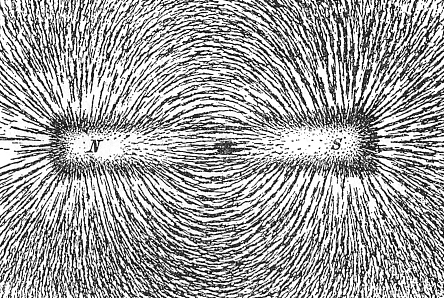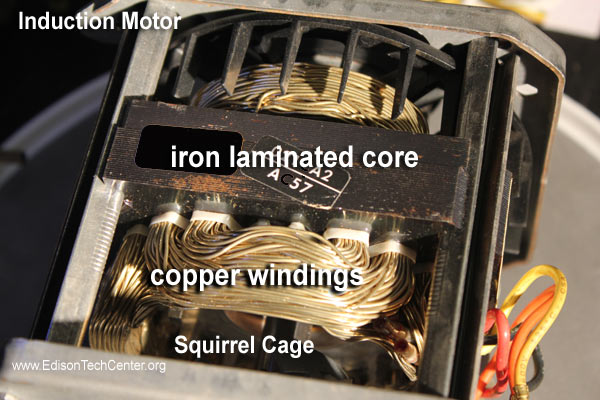Induction and Electromagnetism
Understanding electromagnetic induction
Motors, transformers, audio speakers, radio transmission and generators work using the wild and complex phenomena of electromagnetism. Understanding the behavior of electromagnetism is a large subject of study. There is a reason why it took 60 years after Volta's first battery to get a good powerful dynamo/generator working. In this page we cover basics.
1. How it works
2. Making
it work for us
1. How it works:

Induction (Electromagnetic Induction) - is the production of current in a conductor as it moves through a magnetic field.
A magnet produces lines of magnetic force, as seen in the graphic above. Iron filings align themselves along the invisible lines of flux.
Due to Faraday's Law of Induction if you take a wire and move it back and forth in a magnetic field, you cut across the lines of flux. The magnetic field pushes on electrons in the metal. Copper has 27 electrons, the last two in the orbit are easily pushed on to the next atom. This movement of electrons is electrical flow.
See the video below showing how current is induced in a wire:
If you take a lot of wire such as in a coil and move it in the field, you create a more powerful "flow" of electrons. The strength of your generator or motor depends on:
"l"-Length of the conductor in the magnetic field
"v"-Velocity of the conductor (speed of the rotor)
"B"-Strength of the electromagnetic fieldYou can do calculations using this formula: e = B x l x v
See the video to see all of this demonstrated:
About the magnets:
In most electrical devices magnets are usually not made of natural magnetite or a permanent magnet (unless it is a small generator), but they are copper or aluminum wire coiled around an iron core. Each coil must be energized with some power to make it into a magnet. This coil around iron is called a solenoid. Solenoids are used instead of natural magnetite because the solenoid is MUCH more powerful. A small solenoid can create a very strong magnetic field.

Above: The coils of wire in the generators must be insulated. Generator failure is caused by temperatures rising too high which results in a breakdown of insulation and a short between to parallel wires.
Below: copper coils insulated by a transparent film are coiled and placed in the stator of an electric motor. When energized with a small amount of current they make a very powerful magnetic field.

Terms:
Electromagnetism - study of forces that happen between electrically charged particles
Rotor - part of the generator of dynamo that rotates
Armature - same as a rotor
Flux - the lines of strength in a magnetic field, it is measured in density, SI unit of weber
Stator - magnets in a generator/dynamo that do not move, they establish the stationary magnetic field
Solenoid - a magnet created by a wire coil around an iron/ferris core
Commutator - Learn more detail about them here
Torque - force in a rotational motion2. INDUCTION: Making it work for us
So we learned that we can make power by moving a coil through a magnetic field. The electric motor works in reverse, the magnetic field forces the coil in the armature to rotate. A motor can also be made into a generator by simply reversing the spin and forcing it in a direction it doesn't want to go.
Learn about Motors or Generators >
In an audio speaker we do use a permanent magnet and a lighter copper coil. Like a motor electric current forces the coil to move, but not in a rotational manor. The audio speaker moves in a very limited forward and backward direction. Werner von Siemens was one of the first to conceptualize a loudspeaker, but the details of how to accurately and powerfully reproduce frequencies... and have it sound like something was a trick that was finally figured out in 1921 in Schenectady, NY by CW Rice and EW Kellogg.
Learn about the Loudspeaker >
In a transformer we use electromagnetic induction to transform power to a specific level that we need. One electromagnet (coil) creates a field that induces power in a second coil. The invisible electromagnet field passes through the air and pushes power onto another conductor that is not directly connected. Only AC power passes through a transformer because it is changing in strength as it peaks and valleys. When the current drops the electromagnetic lines of flux collapse or get smaller. These lines of flux move through the second coil, cutting through the conductor. In a sense we create movement without any moving parts.
Learn about the Transformer >

